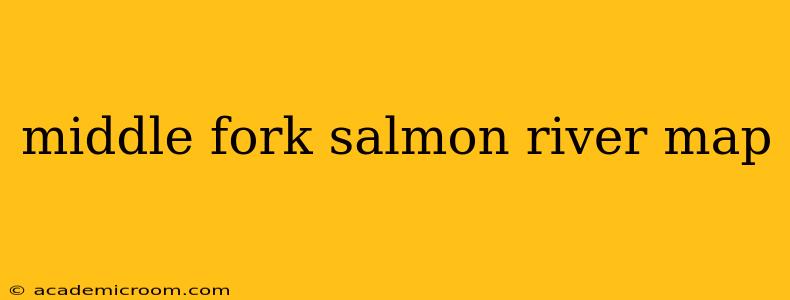The Middle Fork of the Salmon River, a wild and scenic gem in central Idaho, draws adventurers from around the globe. Its pristine waters, dramatic canyons, and challenging whitewater make it a truly unforgettable experience. Navigating this iconic river, however, requires careful planning and a good understanding of the terrain. This guide will help you explore the Middle Fork Salmon River, utilizing maps and providing essential information for your trip.
Where to Find a Middle Fork Salmon River Map?
Finding a detailed map of the Middle Fork Salmon River is crucial for planning a successful trip. While numerous online resources offer general information and some mapping capabilities, the best resource is often a combination of tools:
-
US Forest Service Maps: The Salmon-Challis National Forest, which encompasses the Middle Fork, provides detailed maps available for purchase online or at ranger stations. These maps are invaluable as they show trails, campsites, river access points, and potential hazards. They often have a scale sufficient to plan your daily paddling distances and campsite locations.
-
Topographic Maps: Utilizing topographic maps alongside river-specific maps offers a more comprehensive understanding of the surrounding terrain, including elevation changes, which are particularly important when planning portages or considering potential hazards. These maps are readily available online through sources like USGS (United States Geological Survey).
-
River Guides and Books: Many guidebooks dedicated to the Middle Fork Salmon River include detailed maps and valuable information about rapids, campsites, and points of interest along the river. These guides often offer insights from experienced river runners.
-
GPS Devices and Apps: Modern GPS devices and apps like Gaia GPS or AllTrails can be invaluable tools for navigation, especially in remote areas. However, remember that these should be used in conjunction with paper maps, as electronic devices can malfunction.
What are the Key Features Shown on a Middle Fork Salmon River Map?
A comprehensive Middle Fork Salmon River map will typically include:
- River Course: The main channel of the Middle Fork Salmon River, including meanders, rapids, and significant landmarks.
- Rapids: The location and difficulty rating of rapids are essential for planning your trip. Many maps will use a standardized rating system to assess the difficulty.
- Campgrounds: Designated campsites, often with information on their capacity and amenities (if any).
- Access Points: Locations where you can enter or exit the river, including put-in and take-out points.
- Trails: Hiking trails that intersect with the river corridor, allowing access to scenic overlooks or other points of interest.
- Elevation: Contours showing elevation changes, critical for understanding the river's gradient and potential hazards.
- Points of Interest: Significant geological features, historical sites, or other notable locations along the river.
What is the Best Map for Planning a Middle Fork Salmon River Trip?
The "best" map depends on your needs and experience level. For novice river runners, a combination of a detailed US Forest Service map and a guidebook featuring comprehensive maps is recommended. Experienced rafters might prefer using topographic maps alongside a GPS device. Regardless of your choice, always carry paper maps as a backup.
How Detailed Are Middle Fork Salmon River Maps?
The level of detail varies depending on the map source. US Forest Service maps usually provide sufficient detail for navigation, while topographic maps offer even greater precision. Guidebooks often simplify the information for ease of use, focusing on key features relevant to river runners.
Are There Different Types of Middle Fork Salmon River Maps?
Yes, there are different types, each serving a specific purpose:
- Overview Maps: These provide a general view of the river's course and major features.
- Detailed Maps: These show more granular details, such as rapids, campsites, and trails.
- Topographic Maps: These depict elevation changes and terrain features.
By utilizing a combination of these resources, you can effectively plan and navigate your Middle Fork Salmon River adventure, ensuring a safe and memorable experience in this breathtaking wilderness area. Remember to always check for current conditions and closures before embarking on your journey.
